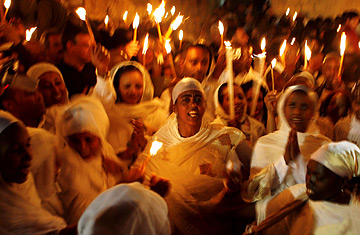
Ethiopian Orthodox Christians sing and dance as they hold candles in the Church of the Holy Sepulcher during the ceremony of the Holy Fire in Jerusalem's Old City, Saturday, April 7, 2007. The Holy Fire ceremony is part of Orthodox Easter rituals and the flame symbolizes the resurrection of Christ.
Moments later, the gloomy church glows incandescent as worshipers press forward to light their candles from the so-called "heavenly fire." Sometimes it isn't just the candles that catch fire — beards and hair crackle spectacularly in the chaotic crush around the flame-bearing priests. Skeptics denounce the ritual as a 1,200-year-old sleight-of-hand whose secret is passed from one generation of high priests to the next. But for the thousands of gathered worshipers, it was proof of God's existence and Christ's resurrection.
But was this really Christ's tomb? Like millions of viewers, I'd seen the Discovery Channel documentary The Lost Tomb of Jesus, which raises the possibility that he was buried in the hills outside Jerusalem, alongside Joseph, his mother Mary, his supposed wife Mary Magdalene, and a boy, aged 10-12 years, named Judah, who could, the filmmakers suggested, have been a son sired by Jesus with Mary Magdalene. So, I decided to take a closer look.
The way to the Holy Sepulcher winds down the Via Dolorosa, the route to Jesus' crucifixion. Nowadays, the route is packed with pushy vendors selling Holy Water, T-shirts championing the Israeli army, sandals and gaudy junk from India. Some reports claim that the site of the church was chosen after the Dowager Queen Helena had ordered the torture of a few rabbis to reveal the location of Christ's crucifixion, and that they may have deliberately given false information.
The road to the Talpiyot tombs dips down from the Hill of Evil Council (the name a source of amusement for many Israelis, since it houses local U.N. headquarters), veers around a traffic circle, and then heads into a suburb of limestone apartment buildings on a hillside with pines and rose gardens. There were no tour buses, nobody hawking candles or postcards, just a few Israelis out for a stroll with their kids and dogs. I asked one dog-walker if he could direct us to the Jesus Family tomb, and he shrugged.
The tomb, unearthed by filmmaker Simcha Jacobovici, was sealed up again with a thick concrete slab. Now it looks like an ordinary piece of concrete flooring in the ordinary garden of an ordinary Israeli suburb, something on which you might put lawn chairs or a kid's wading pool. None of the neighbors seemed keen about the tomb's discovery; after all, they didn't want strangers running through their tidy rose gardens with torches of Heavenly Fire.
For Jacobovici, finding the controversial tombs — debunked by one Biblical scholar as "archeo-porn" — shouldn't shake the foundations of Christian faith at all. He told TIME: "For millions of people, this is inspirational. It could prove that Jesus wasn't a myth — he really existed. People have come up to me and said their faith has been reinforced."
Not all Christians agree. Many see the film as blasphemy, and in the U.S. evangelical groups staged a campaign to ban the Discovery Channel from airing it. Orthodox churches have also condemned it, although the Vatican, so far, has chosen to ignore the fuss.
The resealed tomb may still hold many mysteries. Jacobovici says the strange symbol over its entrance — a swooping chevron over a circle — may have been the precursor of a symbol used by the Templar Knights. "There were also three skulls inside, arranged in a triangle, as if they were guardians," he says. "And that's not something you find in Jewish funeral rites." Jacobovici says the tomb was vandalized, possibly during the Crusader times.
So, did the Templars know about the family of Jesus? Now, we were running into Da Vinci Code territory. Jacobovici grinned enigmatically and glanced at his watch. "Have to run," he said, rising. Back at the Church of the Holy Sepulcher, the many flames of faith were burning bright.
